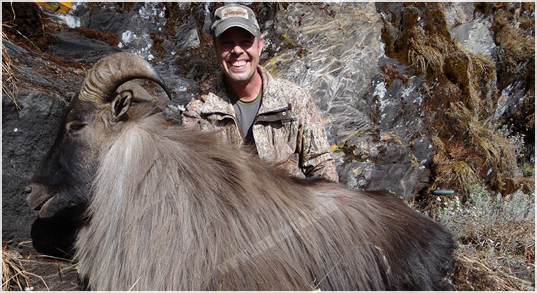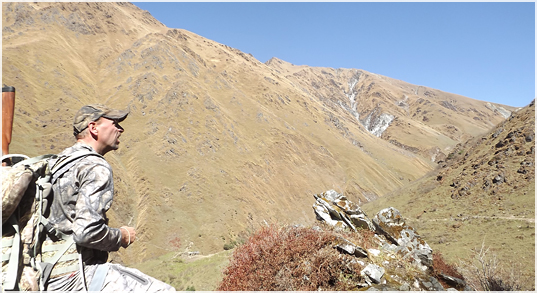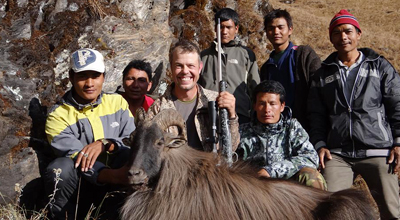Muntjac
Muntjac also called Barking Deer and well as Ratuwa in Nepali Language. Muntjac is the most numerous deer species.IT has a short but very soft, thick, dense coat, especially those living in cooler regions. Coloration of the coat changes from dark to brown to yellowish and grayish brown depending on the season. The Muntjac's coat is golden tan on the dorsal side and white on the ventral side of the body, the limbs are dark brown to reddish brown, and the face is dark brown. However, the ears have very little hair which barely covers them. Male Muntjacs have antlers that are very short about 1-2 inches, usually consisting of only two or three points at the most and protrude from long body hair covered pedicles on the forehead. Females have tufts of fur and small bony knobs where the antlers are located in Males. Males also have slightly elongated upper canines about an inch long that curve slightly outward from the lips and have the capacity to inflict serious injury uppon other animals or to other members of the population while exhibiting aggression. Males are generally larger than females. THe body length of muntjacs varies from 35-53 inches wide and their height ranges from 15-26 inches tall.
Habitat:
The Muntjac is among the most widespread but least known of all mammals in South Asia. It is found in Nepal, Bangladesh, China, India, Srilanka, Pakistan, New Zealand, England and other some countries. This species is most densely located in southest Asia. This species found at altitudes ranging from sea level up to 3000 meter ( 9,800 feet). They are found in tropical and subtropical deciduous forests, grasslands, savannas and scrub forests as well as in the hilly country on the slopes of the Himalayas.
Diet:
Muntjac are classfied as omnivores. They are considered both browsers and grazers with a diet consisting of grasses, ivy, prickly bushes, low growing leaves, bark, twigs, herbs, fruit, sprouts, seeds, tender shoots, bird eggs and small warm blooded animals. Their large canine teeth help in the processes of retrieving and ingesting food.
Reproduction:
Muntjac are polygamous animals. Females sexually mature during their first to second year of life. These females are polyestrous, with each cycle lasting about 14 to 21 days and an estrus lasting for 2 days. The gestation period is six to seven months and they usually bear one offspring at a time but sometimes produce twins. Females usually give birthin dense growth so that they are hidden from the rest of the herd and predators. The young leaves it's mother after about six months to establish it's own territory. Males often fight between one another for possession of a harem of females.
Behavior:
Other than during the rut ( mating season ) and for the first six months after giving birth, the adults Muntjac is a solitary animal. Adult males in particular are well spaced and marking grass and bushes with secretions from their preorbital galnds appears to be involved in the acquisition and maintenance of territory. Males acquire territories their hooves against the ground, and scraping the bark of trees with their lower incisors. These scent markers allow other muntjacs to know whether a territory is occupied or not. Males will often fight with each other over these territories, sufficient vegetation, and for primary preference over females when mating using their short antlers and an even more dangerous weapon, their cannines. If a male is not strong enough to acquire his own territory he will most likely become prey to a leopard or some other predator. During the time of the rut, territorial lines are temporary disregarded and overlap while males roam constantly in search of a receptive female.
Muntjac are higly alert, creatures. When put into a stressful situation or if a predator is sensed, muntjacs will begin making a bark-like sound. Barking was originally throught of as a means of communication between the deer during mating season as well as an alert. However, in more recent studies it has been indentified as a mechanism used dolely in alarming situations meant to cause a predator to realize that it has been detected and more elsewhere or to reveal itself. Barking Deer mechanism is used more frequently when visibility is reduced and can last for over an hour regarding one incident. Muntjac exhibit both diurnality and nocturnality.
Our Hunting Packages
Bluesheep Hunting

Nepal is real highland place in the world. Bluesheep is main hunting species of Nepal Hunting. Bluesheep hunting is challenging, breathtaking and un-paralled sport trophy hunting...
View Detais
Himalayan Tahr Hunting

Himalayan Tahr Hunting in Nepal is neturally tahr hunting in the world. You can have tahr hunting in New Zealand and England too but these are not neturally as like Nepal which was taken from Nepal...
View Detais
Combo Hunt

Nepal is one of the best higland real adventure hunting place in the world. Nepal known as challenging, breathtaking and un-paralleled hunting place in the world. These three words describe about Bluesheep & Himalayan Tahr...
View Detais









